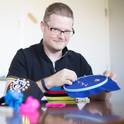This article highlights what inquiry and design have in common, and what makes engineering design uniquely different from inquiry. A case study is presented that gives students practice in conducting fair-test experiments, in troubleshooting to learn how to make designs better, and in building science-based explanations for how things work. The students were made aware that science creates and tests explanations and predictions about nature and how it works, while engineering makes products that solve problems or fulfill the needs of users. The project was the making of a whirligig, a simple model flying toy made from a pattern cut and folded from a sheet of paper and paper clips, that spins and falls slowly when released. Students were asked to design a spinning toy for kids that would be included for free in a box of cereal. The activity was a way to introduce second graders to design and also to give them practice doing fair-test experiments. It demonstrated how to focus on troubleshooting, and on the process of combining ideas to create a "master design" or optimal solution after experimenting with single design variables. Teachers helped students use both science and engineering ideas and practices when solving design challenges where single "right answers" rarely existed. Students were encouraged to be creative, to take risks with ideas when designing, and especially to learn when things fail, which they inevitably do. When implemented well, design activities can lead to deeper understanding of science ideas.
Article
Taking engineering design out for a spin
Science and Children
Document Type
Article
Publisher
ERIC
Publication Date
1-1-2013
Abstract
Citation Information
Crismond, D., Soobyiah, M., & Cain, R. (2013). Taking engineering design out for a spin. Science and Children, 50(5), 52.
